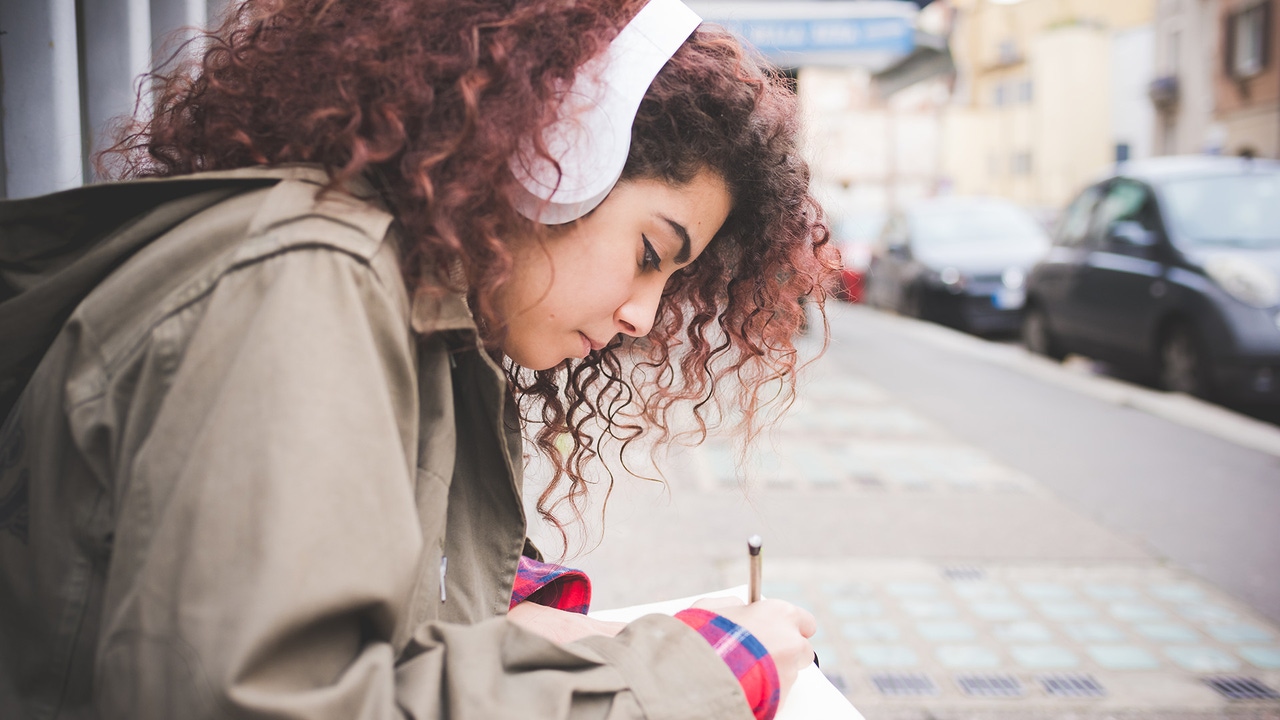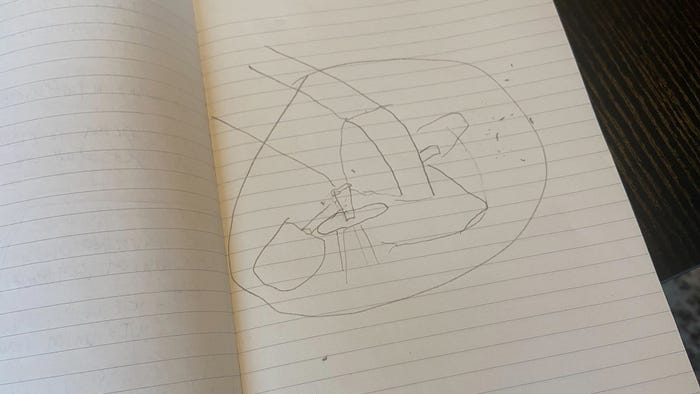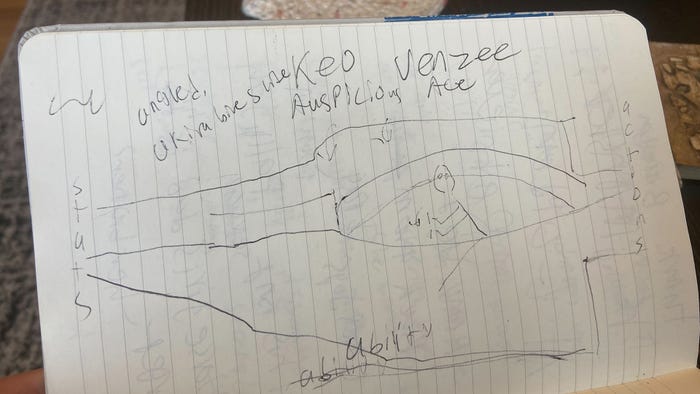Trending
Opinion: How will Project 2025 impact game developers?
The Heritage Foundation's manifesto for the possible next administration could do great harm to many, including large portions of the game development community.
Generative AI art tools make it easy to whip up images for concepts and storyboarding. But don't throw out your pen and paper just yet!

I'm lucky I know enough about visual art to get myself in trouble, so to speak. Just this morning, I was jamming with my friends in the local Star Wars: X-Wing community about a fun logo for "Coffee and X-Wing," a meetup one friend wants to make a regular thing.
We all had different pitches. The first one was a classic TIE Fighter on the side of a coffee cup. Another dug up a photo of a latte with a Stormtrooper helmet. I pitched something more complex: a coffee cup sitting on a table in the foreground, with Boba Fett's ironic Firespray gunship docked in the background.
I needed to sell the silhouette to the group, so I grabbed my notebook and scratched out something quick and dirty as a reference image. Behold. My masterpiece:

Image by Bryant Francis.
Incredible, isn't it? The jagged lines. The terrible perspective. The coffee cup that looks more like a beer stein. I tell you, I'll get to sell prints of this at Star Wars Celebration.
I tossed this out on BlueSky for a laugh and noted my preference for this visualization method over generative AI tools like Midjourney or DALL-E (which face consistent criticism over having been trained on internet-scraped copywritten material). A friend responding to the post hit the nail on the head: "Testament to the power of human-made art, even amateur-level art, is that even with this basic sketch, I can pretty much 100 percent tell what you're going for with your design," he said.
Developers have used bad sketches and mood boards for eons, but are now weighing how to use generative AI tools in their workflows, and one common sentiment bubbling up is that while the technology isn't ready for primetime in-game pipelines just yet, it's great for pre-production concepting. Even the folks at Don't Nod Montreal told us they're using it this way on Lost Records: Bloom and Rage while acknowledging they aren't likely to adopt AI elsewhere.
I can't completely toss out the idea of text-driven art tools. (Although, do they need to scrape copywritten material?) Developers with impairments to their fine motor skills could use them to create visual prototypes that, however crude, could be useful to the process. I also don't want to scare off people who struggle to visualize their ideas and may not have a basic level of visual design training.
But for the rest of the development world, I implore you! Embrace the mess—doing so can be better for your game and your creative spirit.
The second you step into any collaborative medium, you're reliant on the talents of other creative people to make the art or product floating in your head. When you're the vision-holder on a project, you're signing up for both the privilege and the power of telling people what you want to see.
But a constant struggle in game development and corporate art is when works become "directionless." Creative leaders who don't know what they want or how much work it takes to achieve it can be the bane of talented teams and risk running projects off the rails.
Sometimes, it's impossible to know those things. Sometimes, there are good—even great—reasons to stumble through the muck. But a vision holder who appreciates what they're asking of their coworkers will be one who retains their trust and knows what big swings to ask them to make.
Consider this: if I went to a generative AI tool and asked for "table with coffee on it in front of Firespray gunship," I'd get a glossy image filled with sharp lines, beautiful light, and loaded with fine detail.
(Quick note, I find most AI-generated art to be ugly and off-putting. Even with the "hands" problem regularly improving, the muddy details sneak up on me and fill me with unease. It's why generative AI visuals that aim for uncanniness and dread have a better impact on me).
If I handed that to my artist friend and said "here, draw this," (because for some reason I have not picked the cheap way out and just used that art for the logo) I might not appreciate what it takes to recreate that illusion of fidelity. Something I've noticed about generative AI assets, in particular, is that they can be densely loaded with detail that looks impressive, but is often nonsensical and would take a normal artist a lot of time to capture the essence of.
But because I sketched out a thumbnail of the ship formerly known as Slave I first, I have a sense of what my friend would be doing when he went all in. There has to be a sense of perspective. The ship has to be visually tweaked to not overwhelm the coffee cup's prominence in the frame. The Firespray has a strange design, and if you want it to resemble that particular ship, it takes effort to compress the key visual elements in what will be a logo-sized space.
That means if he came back and said "this won't work for X/Y reason," I can go "oh that makes sense, I had trouble drawing that in my sketch."
Speaking of communication and trusting your artists...
In 2023 I asked my friend Angi Trizziano if she could draw some fan art of Star Wars Squadrons nonbinary icon Keo Venzee for me. I knew vaguely what I wanted it to look like: something with the energy of the Akira bike slide but keeping them visible in the cockpit of an A-Wing. Keo is the pilot who teaches players how to "drift" in Squadrons, a unique flying mechanic that adds a fresh spin to the dogfighting simulator.
Behold, another wonderful sketch. This one has arrows.

Image by Bryant Francis.
I don't know why I scratched out the word "ability" and wrote "ability" above it.
Anyway, I sent this and a ton of reference images to Trizziano (go hire her). We did back-and-forth on ideas and notes over a few months, and here's what she finally handed back to me:
Image by Angela Trizziano.
Did Trizziano fill in the blanks? Hell yes she did. The character and ship designs are all originally by EA Motive and Lucasfilm, leaving Trizziano free to play with penmanship, facial expression, pose, etc. A major change in the art direction of this piece was the addition of the manga-inspired "popout" of Keo that could let her illustrate the detail on their face and preserve the eye-grabbing silhouette of the A-Wing in the background.
This is a step where I think most non-artists struggle the most, rather than a lack of technical skill. Sending your art to another person and asking them to react makes you vulnerable.
Some people may have more reasons than others to be vulnerable. Maybe you have a memory of drawing something as a kid, showing it to someone else, and them laughing at it?
If you do, it's okay. I promise people want to see what you made.
I remember in elementary school, I would spend every art class failing to do the assignment (god I hated paper mache) and instead grabbing sketch paper to draw out battle plans for Star Wars. Later on, it would be maps of fantasy worlds. At some point, I remember trying to do high-quality drawings of second-generation Digimon.
Did I draw any of these with high-minded goals to be an artist? Of course not; I was a literal child with undiagnosed ADHD who wanted to have fun. Sketching is fun. Dreaming up other worlds is fun. Recreating your favorite fictional characters is fun.
You know what else is fun? Writing ideas for your fantasy epic. Plucking at an instrument. Singing in the shower. Pretending to model in front of a mirror. Programming your first game of Pong. Cooking up changes you'd make to your favorite board or video game. A pickup game of basketball. Racing your bicycle down a hill. Going out and exploring in the woods.
The world greets us by showing how joyous it can be to live in it, and the amateur knows what the professional may sometimes forget: that so much of what we do begins with having fun.
So draw some really shitty art. Hum a few off-key bars into your phone. Write a bad story pitch for your narrative team. Have faith in yourself and those around you that your talents, professionalism, and trust will be the process that turns it into good art.
You May Also Like